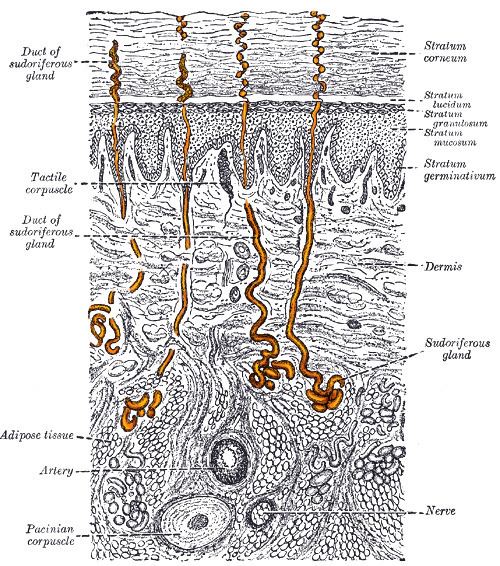MeSH A10.336.899.480 | System Integumentary TH H3.12.00.3.03009 | |
 | ||
Nerve Cholinergic sympathetic nerves Latin Glandula sudorifera merocrina;Glandula sudorifera eccrina | ||
Eccrine glands (/ˈɛkrən/, /ˈɛˌkraɪn/, or /ˈɛˌkrin/; from ekkrinein "secrete"; sometimes called merocrine glands) are the major sweat glands of the human body, found in virtually all skin, with the highest density in palms and soles, then on the head, but much less on the trunk and the extremities. In lower mammals, they are relatively sparse, being found mainly on hairless areas such as foot pads. They reach their peak of development in humans, where they may number 200–400/cm² of skin surface. They produce a clear, odorless substance, consisting primarily of water and NaCl. NaCl is reabsorbed in the duct to reduce salt loss, but is dysfunctional in cystic fibrosis thus producing salty sweat. They are active in thermoregulation by providing cooling from water evaporation of sweat secreted by the glands on the body surface and emotional induced sweating (anxiety, fear, stress, and pain). The white sediment in otherwise colorless eccrine secretions is caused by evaporation that increases the concentration of salts.
The odour from sweat is due to bacterial activity on the secretions of the apocrine sweat glands, a distinctly different type of sweat gland found in human skin.
Eccrine glands are composed of an intraepidermal spiral duct, the "acrosyringium"; a dermal duct, consisting of a straight and coiled portion; and a secretory tubule, coiled deep in the dermis or hypodermis. The eccrine gland opens out through the sweat pore. The coiled portion is formed by single layer of columnar or cuboidal epithelial cells, which are secretory in nature. The epithelial cells are interposed by the myoepithelial cells. Myoepithelial cells support the secretory epithelial cells. The duct of eccrine gland is formed by two layers of cuboidal epithelial cells. Eccrine glands are innervated by the sympathetic nervous system, primarily by cholinergic fibers whose discharge is altered primarily by changes in deep body temperature (core temperature), but by adrenergic fibers as well. The glands on palms and soles do not respond to temperature but secrete at times of emotional stress.
Secretion
Eccrine glands function from birth throughout life. The secretion of eccrine glands is a sterile, dilute electrolyte solution with primary components of bicarbonate, potassium, and sodium chloride (NaCl), and other minor components such as glucose, pyruvate, lactate, cytokines, immunoglobulins, antimicrobial peptides (e.g., dermcidin), and many others. Dermcidin is a newly isolated antimicrobial peptide produced by the eccrine sweat glands.
